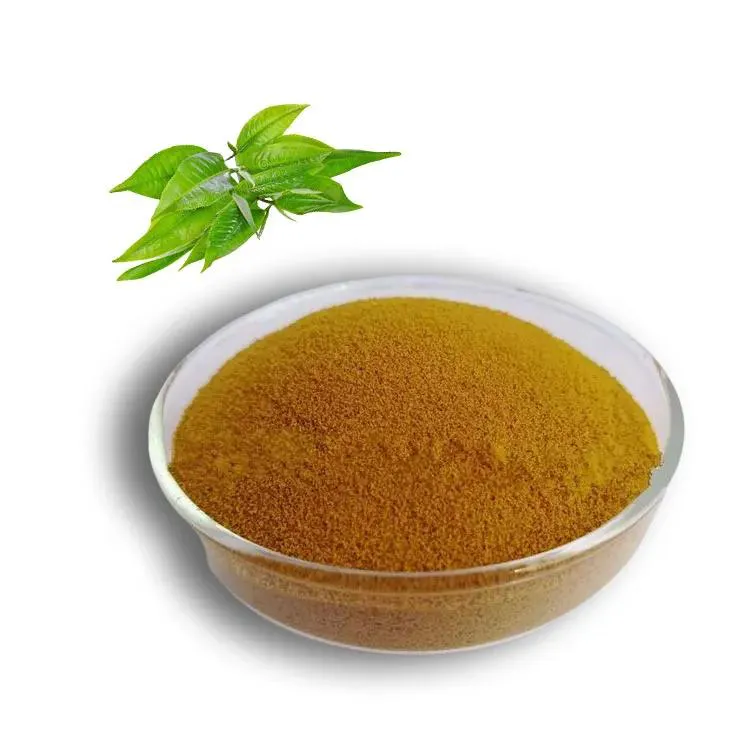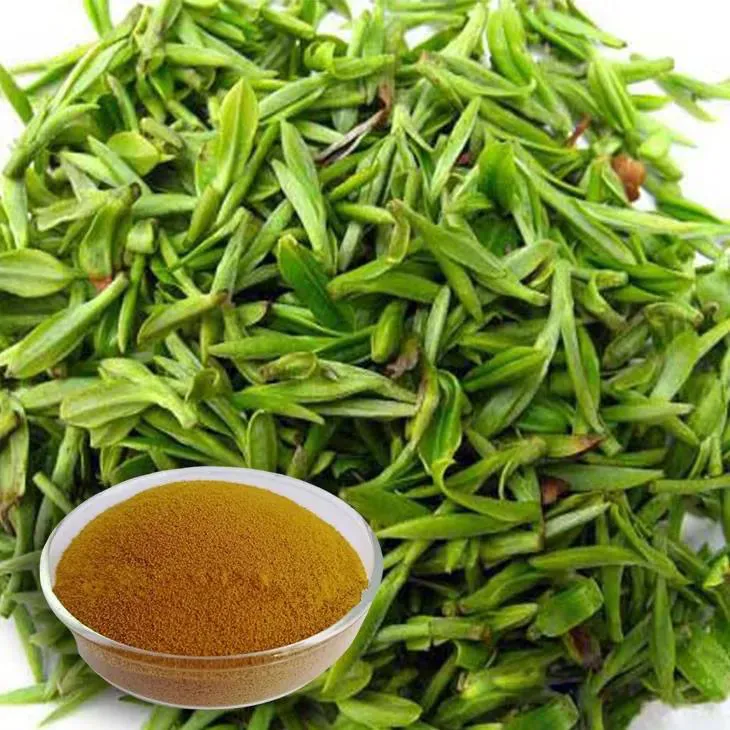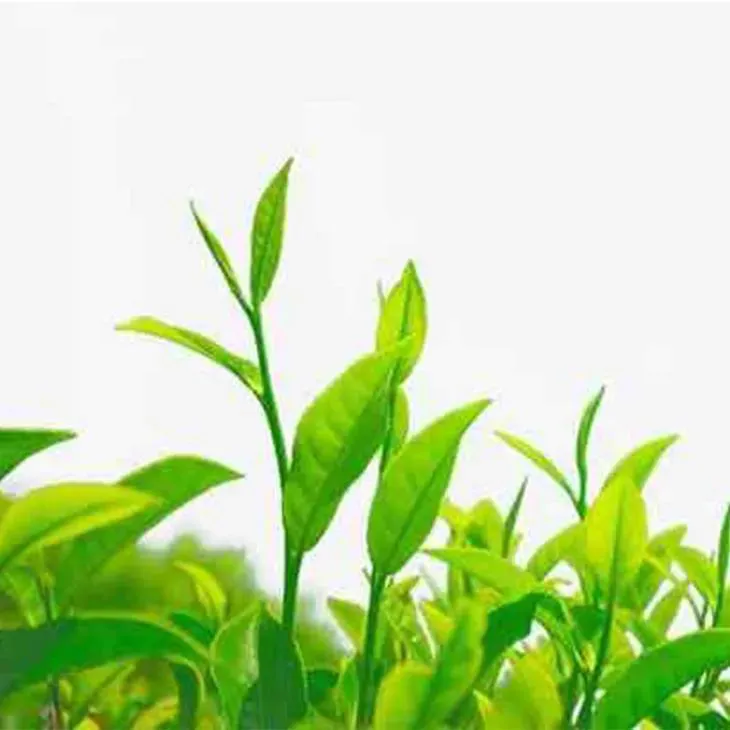- 0086-571-85302990
- sales@greenskybio.com
Components of Green Tea Extract in Fertilizers and Feeds.
2024-11-29

1. Introduction
Green Tea Extract has emerged as a valuable component in both fertilizers and feeds. The unique properties of Green Tea Extract offer numerous benefits in these two important areas. In recent years, with the increasing emphasis on sustainable agriculture and livestock production, the exploration and utilization of Green Tea Extract have gained more attention.

2. Green Tea Extract in Fertilizers
2.1 Chemical Components in Green Tea Extract Relevant to Fertilization
Green tea extract contains various substances that can influence soil and plant growth. Polyphenols, for example, are one of the major components. These polyphenols can have antioxidant effects in the soil environment. They can interact with soil particles and play a role in soil aggregation, which is beneficial for soil structure improvement. Another important component is amino acids. Amino acids are the building blocks of proteins and can be directly absorbed by plants. They can enhance plant resistance to stress and also participate in plant physiological processes such as photosynthesis.
2.2 Effects of Green Tea Extract on Soil pH
The soil pH is a crucial factor affecting plant growth. Green tea extract can help adjust soil pH in several ways. Some of the acidic components in the extract can slightly lower the soil pH in alkaline soils. This is important because many plants prefer slightly acidic to neutral soil conditions. For example, in some regions where the soil is alkaline, the application of green tea extract - based fertilizers can create a more favorable soil environment for acid - loving plants such as blueberries. Alkaline substances in the green tea extract may also buffer the soil in acidic soils, preventing excessive acidity.
2.3 Influence on Soil Microbial Community Structure
Green tea extract has a significant impact on the soil microbial community. It can act as a source of nutrients for soil microorganisms. The polyphenols and other organic substances in the extract can be decomposed by certain microorganisms, which in turn promotes their growth. For instance, some bacteria can utilize polyphenols as an energy source. The growth of these bacteria can then have a cascading effect on the entire microbial community structure. Beneficial microorganisms such as nitrogen - fixing bacteria and phosphorus - solubilizing bacteria may increase in number. This is beneficial for plant nutrient uptake as nitrogen - fixing bacteria can convert atmospheric nitrogen into a form that plants can use, and phosphorus - solubilizing bacteria can make phosphorus in the soil more available to plants.
2.4 Facilitation of Plant Nutrient Uptake
As mentioned above, green tea extract can improve soil structure and microbial community, both of which are closely related to plant nutrient uptake. The improved soil structure allows for better root penetration and water - nutrient movement in the soil. The enhanced microbial activity can release more nutrients from the soil. For example, the increase in phosphorus - solubilizing bacteria can make more phosphorus available for plant roots to absorb. Additionally, some components in the green tea extract may directly affect plant root physiology. They can stimulate root growth and development, increasing the root surface area for nutrient absorption.

3. Green Tea Extract in Feeds
3.1 Bioactive Components in Green Tea Extract for Animal Health
Green tea extract is rich in bioactive components that are beneficial for animal health. Catechins, which are a type of polyphenol, are among the most important ones. Catechins have strong antioxidant properties in animals. They can scavenge free radicals in the animal's body, reducing oxidative stress. Another component is theanine, which has a calming effect on animals. It can help reduce stress levels in animals, especially in high - production livestock such as poultry and pigs. These bioactive components can also enhance the immune system of animals, making them more resistant to diseases.
3.2 Anti - inflammatory Effects in Animals
Inflammation is a common problem in animal production, which can lead to reduced growth performance and increased susceptibility to diseases. Green tea extract has significant anti - inflammatory effects. The polyphenols in the extract can inhibit the production of inflammatory mediators in animals. For example, they can reduce the production of cytokines such as interleukin - 6 and tumor necrosis factor - alpha. This helps to maintain a healthy inflammatory response in animals and promotes their overall well - being. In poultry, anti - inflammatory effects of green tea extract can reduce the incidence of foot - pad dermatitis, which is a common inflammatory condition in intensive poultry production.
3.3 Anti - stress Capabilities
Animals in modern livestock production often face various stressors, such as heat stress, transportation stress, and crowding stress. Green tea extract can help animals cope with these stressors. Theanine in the extract can regulate the animal's stress response system. It can reduce the release of stress hormones such as cortisol. In pigs, for example, during the transportation process, the addition of green tea extract to the feed can reduce the negative impacts of transportation stress on pigs, such as reduced feed intake and increased mortality. This is crucial for the sustainable development of the livestock industry as it can improve animal welfare and production efficiency.
3.4 Impact on Animal Growth and Productivity
The use of green tea extract in feeds can have a positive impact on animal growth and productivity. By reducing stress and inflammation, animals can allocate more energy towards growth. In addition, the improved immune system can also contribute to better growth performance. For example, in broiler chickens, the addition of green tea extract to the feed has been shown to increase body weight gain and improve feed conversion ratio. In dairy cows, it can also increase milk production and improve milk quality.

4. Safety and Quality Considerations
4.1 Safety of Green Tea Extract in Fertilizers and Feeds
When using green tea extract in fertilizers and feeds, safety is of utmost importance. In fertilizers, the potential impact on soil ecology and water quality needs to be carefully evaluated. Although green tea extract is generally considered safe, excessive use may lead to changes in soil chemistry that could have unforeseen consequences. In feeds, the safety of green tea extract for different animal species needs to be ensured. Some components in the extract may interact with other feed ingredients or medications. For example, catechins may bind to certain drugs, reducing their efficacy. Therefore, proper dosage and compatibility studies are necessary.
4.2 Quality Control of Green Tea Extract - based Products
Quality control is essential for green tea extract - based fertilizers and feeds. For fertilizers, the content of active components in the green tea extract should be accurately measured and standardized. This ensures that the expected effects on soil and plants are achieved. In feeds, the quality of green tea extract needs to be monitored to ensure its consistency in terms of bioactive components. The extraction process should be carefully controlled to avoid contamination and ensure the purity of the extract. For example, the presence of pesticides or heavy metals in green tea leaves can be transferred to the extract and then to the fertilizers or feeds, which can pose risks to plants, animals, and ultimately humans.
5. Future Perspectives
5.1 Research and Development Needs
There are still many areas that require further research regarding green tea extract in fertilizers and feeds. In fertilizers, more in - depth studies on the long - term effects on soil fertility and plant health are needed. The interaction mechanisms between green tea extract and different soil types also need to be explored further. In feeds, more research is needed to fully understand the optimal dosage and combination with other feed additives for different animal species. Additionally, the potential of green tea extract in improving animal reproduction performance is an area that has not been fully explored.
5.2 Market Potential and Commercialization
The market potential for green tea extract - based fertilizers and feeds is significant. As consumers are becoming more conscious about sustainable and healthy products, the demand for such products is likely to increase. However, for commercialization, challenges such as cost - effectiveness and product acceptance need to be addressed. The production cost of green tea extract - based products needs to be reduced to make them more competitive in the market. At the same time, more efforts are needed to promote the understanding and acceptance of these products among farmers and livestock producers.
FAQ:
Q1: What are the main components of green tea extract that can adjust soil pH in fertilizers?
Green tea extract contains polyphenols, alkaloids such as caffeine, and amino acids. Some of these components, especially polyphenols, can interact with the soil components. They may release or bind certain ions in the soil, thus affecting the soil pH. For example, polyphenols can chelate with metal ions, which might change the chemical equilibrium in the soil and influence its acidity or alkalinity.
Q2: How does green tea extract in feed promote anti - inflammatory effects in animals?
The polyphenols in green tea extract, like epigallocatechin - 3 - gallate (EGCG), are known for their antioxidant properties. In animals, oxidative stress can lead to inflammation. These polyphenols can scavenge free radicals, reducing oxidative stress. By reducing oxidative stress, they can prevent the activation of inflammatory pathways in the animal's body, thus promoting anti - inflammatory effects.
Q3: Can green tea extract in fertilizers enhance the growth of all types of plants?
While green tea extract has potential benefits for plant growth, it may not enhance the growth of all types of plants equally. Different plants have different nutrient requirements and sensitivities to soil conditions. Some plants may respond well to the changes in soil pH and microbial community structure induced by green tea extract, while others may not be as responsive. For example, acid - loving plants may benefit more from the pH - adjusting effect of green tea extract in alkaline soils compared to plants that prefer neutral or alkaline soils.
Q4: What is the mechanism of green tea extract in feed to relieve animal stress?
Green tea extract can regulate the hormonal balance in animals. When animals are under stress, their hormonal levels change. The components in green tea extract can interact with the endocrine system. For instance, it may affect the levels of stress hormones like cortisol. By modulating these hormonal levels, it helps the animals to better cope with stressors, thus relieving stress.
Q5: Are there any potential negative impacts of using green tea extract in fertilizers?
Although green tea extract has many potential benefits in fertilizers, there could be some potential negative impacts. If not used properly, the substances in green tea extract may cause an over - adjustment of soil pH in some cases. Also, the decomposition of green tea extract components in the soil may consume a certain amount of oxygen, which could potentially affect the soil aeration. However, with proper application methods and dosages, these negative impacts can be minimized.
Related literature
- The Role of Green Tea Extract in Agricultural Fertilization"
- "Green Tea Extract in Animal Feed: A Review of Health Benefits"
- "Components of Green Tea and Their Impact on Soil - Plant Interaction"
- ▶ Hesperidin
- ▶ citrus bioflavonoids
- ▶ plant extract
- ▶ lycopene
- ▶ Diosmin
- ▶ Grape seed extract
- ▶ Sea buckthorn Juice Powder
- ▶ Beetroot powder
- ▶ Hops Extract
- ▶ Artichoke Extract
- ▶ Reishi mushroom extract
- ▶ Astaxanthin
- ▶ Green Tea Extract
- ▶ Curcumin Extract
- ▶ Horse Chestnut Extract
- ▶ Other Problems
- ▶ Boswellia Serrata Extract
- ▶ Resveratrol Extract
- ▶ Marigold Extract
- ▶ Grape Leaf Extract
- ▶ blog3
- ▶ blog4
-
100% Pure Organic Pitaya Powder
2024-11-29
-
Manufacturers of seabuckthorn juice powder.
2024-11-29
-
Organic Yohimbe Bark Extract, Australia.
2024-11-29
-
The best plantain extract in nature.
2024-11-29
-
Organic Oat Straw Extract Powder Factory.
2024-11-29
-
Boswellia Serrata Extract
2024-11-29
-
Tinospora cordifolia extract
2024-11-29
-
Kelp Extract Powder
2024-11-29
-
Horse Chestnut Extract
2024-11-29
-
Lotus leaf extract
2024-11-29
-
Maca Extract
2024-11-29
-
Nutmeg Extract
2024-11-29
-
Pomegranate Extract
2024-11-29
-
Nettle leaf extract
2024-11-29
-
Medicinal Marshmallow Extract
2024-11-29





















